 Welcome to another Science Saturday late edition! This week, discover the smallest exoplanet yet, go “face mining” with TOS, deflect asteroids and save the Earth, and go out this weekend for a great sky show. All this plus our gadget of the week: Celestron Digital Microscope!
Welcome to another Science Saturday late edition! This week, discover the smallest exoplanet yet, go “face mining” with TOS, deflect asteroids and save the Earth, and go out this weekend for a great sky show. All this plus our gadget of the week: Celestron Digital Microscope!
The Most Earth-like Planet Ever Discovered
So far in the hunt for extra-solar Earth-like planets, many massive Jupiter-sized planets have been found that could swallow 1000 Earths. Not exactly “Earth-like”. But, this week, scientists zeroed-in on Gliese 581e, only 1.9 times the size of Earth, and Gliese 581d, which is located within the system’s “habitable zone” — a region around a sun-like star that would allow water to be liquid on the planet’s surface. Gliese e is too close to the star and Gliese d is too large, and therefore neither could not support human life. Even so, this discovery shows us that the likelihood of spotting a planet very much like our own is not so remote. Now, we just need to solve the traveling faster than light speed to get to these places. Mr. Cochrane?
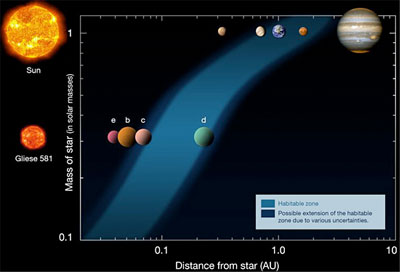
The hunt is on for Earth-like exoplanets
Face Mining Star Trek
Facial recognition technology is getting better and better, and is becoming more and more available for consumer use. Even products like Apple iLife ’09 automatically recognizes your friends and lets you search by faces. Now, the company pittpatt has taken this tech even one step further. And, they’ve chosen to demo the product by categorizing Star Trek TOS episodes (lucky us!). Their website describes just what the service of “Face mining” is:
Here we illustrate the face mining concept for the TV series Star Trek. Specifically, we applied our state-of-the art algorithms in face detection, face tracking and face recognition to 67 Star Trek episodes over three seasons. This process automatically extracts all visible face tracks, and clusters these into a small number of same-person groupings. Currently, we recognize frontal or near-frontal tracks. In the near future, we will extend our results to non-frontal tracks as well. Given our face mining output, it took a person less than five minutes to assign names to all the main characters (Kirk, Spock, Mccoy, Uhura, Scotty, Sulu and Chekov) and a couple of minor ones (Janice, Nurse Chapel) across all 67 episodes.
The website allows you to see the tech in action with a hand full of example episodes they have already “tagged” with faces. This could be the first step towards an entirely new kind of search engine. And, it’s great to see it being tested on Star Trek first! Check out their website at http://facemining.pittpatt.com.
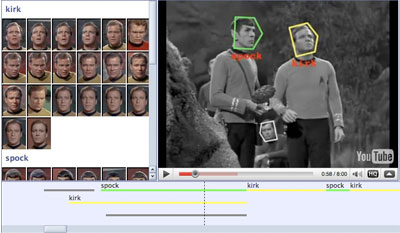
A new way to track characters through Star Trek
How To Deflect Asteroids And Save Earth
Aerospace engineer David French has been studying how one might go about diverting an asteroid that was scheduled to collide with the Earth. He has published a new novel technique that show the most promise of completing such a task. The process involves attaching a long tether and ballast to the incoming object. By attaching the ballast, French explains, “you change the object’s center of mass, effectively changing the object’s orbit and allowing it to pass by the Earth, rather than impacting it.” Hopefully we won’t have to worry about this issue, but just in case: Thanks, David French!
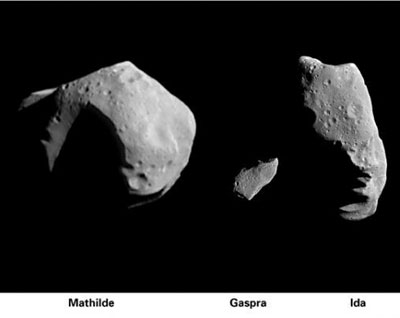
Views of 3 asteroids imaged at close range by spacecraft
SkyWatch: April 26th Twilight Sky Show
On Sunday evening, the crescent Moon, Mercury and the Pleiades star cluster will gather for a three-way conjunction in the western sky. It’s a must-see event. The show begins before the sky fades to black. The Moon pops out of the twilight first, an exquisitely slender 5% crescent surrounded by cobalt blue. Shortly after the Moon appears, Mercury materializes just below it. To the naked eye, Mercury looks like a pink 1st-magnitude star. As the twilight deepens, your eyes will dark-adapt and the Pleiades will come into focus. Also known as the Seven Sisters, the Pleiades are a cluster of young stars about a hundred light years from Earth. They form a miniature Little Dipper located, on this particular evening, halfway between Mercury and the Moon.
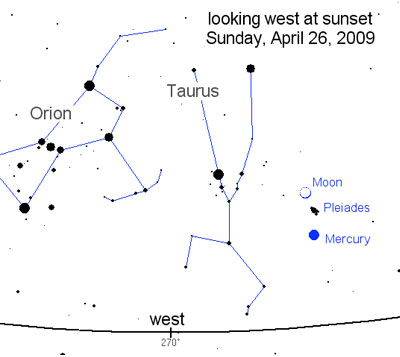
Get some great stargazing in this weekend
Pic of the Week: Sky Panorama Over lake Salda
As midnight approached, a spectacular sky appeared. Such was the case last month from the shore of Lake Salda in southwestern Turkey. In the above night sky panorama, rocky sand covers the foreground, while building lights are visible across the lake. Looking up, the stars of Orion lie just ahead, while Sirius, the brightest star in the sky, appears to Orion’s left. To Orion’s right, just above the horizon, lies the Pleiades open star cluster. Arching across the sky is the central band of our Milky Way Galaxy. High in the center, the stars Castor and Pollux are visible. Lake Salda is famous partly for its blue color that is slightly discernable even in the above image.
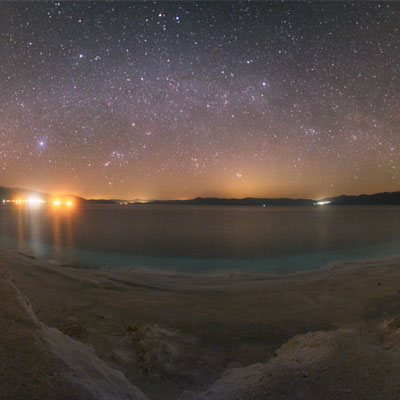
Click the image for a larger version
Gadget of the Week: Celestron Digital Microscope
No need to hide it — you’re a geek. It’s okay, you’re among friends! People like us, we grew up with a constant fascination for everything in the world around us. Now, the technology is better and cheaper, and for only $180, you can get 240x closer to those miniature creepy crawlies, and even get a 1920x peek when you use its 8X digital zoom. And, to document your explorations, there is a built in 2-megapixel camera and slot for an SD card. You can even hook up the scope with a USB right to your computer so you can upload photos to your blog and show all your friends. Nice. You can preorder your scope now on the Celestron website.
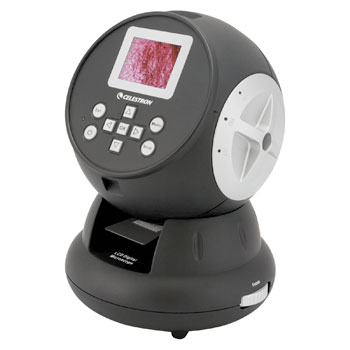
Geek out with the new Celestron Digital Microscope!
Science Quickies
Not enough science for you? Here’s a warp-speed look at some more science tid-bits that are worth a look.
- First “Garden Hose” jet trail nebula discovered

Deflecting Asteroids…Sheer Elegance in its simplicity!
DEE DEE DEE
I’ll bet the first Earth-like planet they find will be Romulas!
World o d o r k s
Why are asteroids called asteroids and hemmorhoids called hemmorhoids? Shouldn’t it be the other way around? Then a proctologist would be called an astronaut!
Hey-ohh!!
NEW CLIPS!
http://www.iesb.net/index.php?option=com_ezine&task=read&page=1&category=5&article=6781
Have any of the discovered exoplanets affected the writing of any science fiction novels? Is there are article written about this subject? I haven’t been able to find anything written about exoplanets and science fiction novels.
Clips look awesome. Thanks SaphronGirl. I particularly liked the Space Jump one. Hopefully, Anthony will see them and do an analysis for them soon. Less than 2 weeks left.
#3. Romulus Dude, Romulas would be Commander Donatra, know what I’m Sayin’….
#6–Love the clips! I can’t wait to see the whole space jump. This movie will rock! I am really having a hard time waiting these last two weeks.
Facial recognition…
On season1 episode 3 at about 1:14 the program identifies a guest star acting as helmsman as “Scotty”….FAIL.
:p
7 Terence
Check out the “Coyote Series” (and other great novels / short stories) by Allen Steele. His writing is charged with recent discoveries and plausible technologies. He’s often called “the modern day Robert A. Heinlein.” The Coyote novels are about the struggle to colonize a habitable, earth-like moon, orbiting a ringed gas giant in a ‘relatively nearby’ solar system.
I’d sure appreciate seeing some of A. Steele’s visions translated to film.
http://en.wikipedia.org/wiki/Allen_Steele
http://www.coyoteseries.com/
I read about that planet on Yahoo! :D
Very, very exciting, ‘specially for me, Miss “I Want To Believe”. xD
(Too much X-Files, Fringe, and Star Trek? Impossible…)
THANK GOD~~
I’m so glad to have found this!~
I really appreciated your picture of Orion as it is about to set until August or so when it will appear in the skies shortly before sunrise.
I happened to catch NOVA last night in the local PBS Station. Maybe this is old news to you, but it was one of the most fascinating ones I’ve ever seen. It was about Black Holes … specifically the one that seems to have been proven during this special to exist in the center of the Milky Way. There are some underappreciated scientists featured in this episode … first the one who estimated the center of the galaxy by pointing an infrared device attached to a telscope around from here to there, determining (correctly) by the intensity of stars that the center of the galaxy was somewhere in or near the constellation Saggitarius, obscurred from us visually by a thick layer of dust that rides the galactic midplane.
The other scientist was someone who had figured out a way to optically correct any picture to “un-blur” it even as the atmosphere’s refractions cause great distrotions in a distant object’s true appearance. As she described her abilities, she said she could be in Los Angeles and make a person’s hand with the thumb’s up in New York visible. Together, they tracked stars making eliptical orbits around an unseen object, and there they had their black hole. We were then given astonishingly new views inside a black hole which is beyond any ever described so far by Sci-Fi (although I don’t catch much Sci-Fi) where even light travels round and round and never goes into the center or escapes, even as the matter is either absorbed the crushing density or converted to energy. One of the most interesting things to me was the “near miss,” where objects vaporize between getting pulled in or escaping, and swirling jets of gas escape after gaining density as beams of poles escaping at nearly the speed of light. We have actually seen many such jets shooting from the poles of black holes, but these are in fact temporary phenenemons as the fuel sources supplying their existence is temporary and finite.
Wow, I have to say that was probably the coolest thing I’ve ever seen on NOVA.